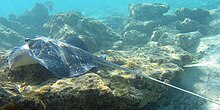| Mangrove whipray | |
|---|---|

| |
| Scientific classification | |
| Domain: | Eukaryota |
| Kingdom: | Animalia |
| Phylum: | Chordata |
| Class: | Chondrichthyes |
| Subclass: | Elasmobranchii |
| Order: | Myliobatiformes |
| Family: | Dasyatidae |
| Genus: | Urogymnus |
| Species: | U. granulatus
|
| Binomial name | |
| Urogymnus granulatus (W. J. Macleay, 1883)
| |

| |
| Range of the mangrove whipray[2] | |
| Synonyms | |
| |
The mangrove whipray (Urogymnus granulatus) or whitetail stingray, is a species of stingray in the family Dasyatidae. It is widely distributed in the Indo-Pacific region from the Red Sea to northern Australia and Micronesia. A benthic inhabitant of shallow inshore waters, juvenile mangrove whiprays favor mangrove and estuarine habitats, while adults favor sandy to rocky areas in lagoons and coral reefs. This species can be identified by its thick, oval pectoral fin disc that is dark gray above with numerous white flecks, and by its relatively short, whip-like tail that is white past the stinging spine. It grows up to 1.4 m (4.6 ft) across.
Solitary in nature, the mangrove whipray preys mainly on small, bottom-dwelling bony fishes and invertebrates. It is, like other stingrays, aplacental viviparous, with the females nourishing their unborn young via histotroph ("uterine milk"). The mangrove whipray is caught for its meat, skin, and cartilage across much of its range. The International Union for Conservation of Nature (IUCN) has assessed it as Vulnerable globally and as Endangered in Southeast Asia, where its population has declined substantially due to intensive artisanal and commercial fisheries as well as widespread habitat degradation. In particular, juvenile rays have been disproportionately targeted by fishers and affected by the large-scale destruction of mangrove forests.
- ^ Manjaji Matsumoto, B.M.; White, W.T.; Fahmi, Ishihara, H.; Morgan, D.L. (2020). "Urogymnus granulatus". IUCN Red List of Threatened Species. 2020: e.T161431A177282313. doi:10.2305/IUCN.UK.2020-3.RLTS.T161431A177282313.en. Retrieved 19 November 2021.
{{cite journal}}: CS1 maint: multiple names: authors list (link) - ^ Cite error: The named reference
last and stevenswas invoked but never defined (see the help page).
